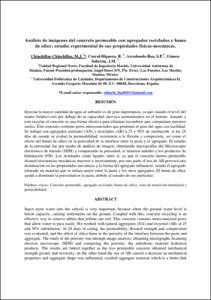Mostra el registre d'ítem simple
Análisis de imágenes del concreto permeable con agregados reciclados y humo de sílice; estudio experimental de sus propiedades físicas-mecánicas
| dc.contributor.author | Chinchillas-Chinchillas, Manuel J. |
| dc.contributor.author | Corral Higuera, Ramon |
| dc.contributor.author | Arredondo Rea, Susana Paola |
| dc.contributor.author | Gómez Soberón, José Manuel Vicente |
| dc.contributor.other | Universitat Politècnica de Catalunya. Departament de Construccions Arquitectòniques II |
| dc.date.accessioned | 2016-01-19T09:25:07Z |
| dc.date.available | 2020-04-20T00:25:59Z |
| dc.date.issued | 2015 |
| dc.identifier.citation | Chinchillas-Chinchillas, M., Corral, R., Arredondo, S., Gómez-Soberón, J.M. Análisis de imágenes del concreto permeable con agregados reciclados y humo de sílice; estudio experimental de sus propiedades físicas-mecánicas. A: Congreso Internacional de Ciencias de la Ingeniería. "Ponencias del II Congreso Internacional de Ciencias de la Ingeniería 2015 : Los Mochis, Sinaloa, México : 18-20 noviembre 2015". Los Mochis, Sinaloa: 2015, p. 1-6. |
| dc.identifier.uri | http://hdl.handle.net/2117/81656 |
| dc.description.abstract | Inyectar la mayor cantidad de agua al subsuelo es de gran importancia, ya que cuando el nivel del manto freático está por debajo de su capacidad, provoca asentamientos en el terreno. Aunado a esto reciclar el concreto es una forma efectiva para eliminar escombros que contaminan nuestros suelos. Éste concreto contiene poros interconectados que permiten el paso del agua con facilidad. Se trabajó con agregados naturales (AN) y reciclados (AR) a 25 y 50% de sustitución. A los 28 días de curado se evaluó la permeabilidad, resistencia a la flexión y compresión, así como el efecto del humo de sílice en la porosidad de la interface entre la pasta y el agregado. El estudio de la porosidad fue por medio de análisis de imagen, obteniendo micrografías del Microscopio electrónico de barrido (SEM) y comparando la porosidad, el material anhidro y los productos de hidratación (PH). Los resultados están ligados entre sí, ya que el concreto menos permeable alcanzó resistencias mecánicas mayores e inversamente, por otra parte el uso de AR provocó una disminución en las propiedades mecánicas y la forma del agregado influenció, siendo el agregado triturado un material que se enlaza mejor entre la pasta y los otros agregados. El humo de sílice ayudó a disminuir la porosidad en la pasta, debido al tamaño de sus partículas. (ANGLÈS) Inject more water into the subsoil is very important, because when the ground water level is below capacity, causing settlements on the ground. Coupled with this, concrete recycling is an effective way to remove debris that pollute our soil. This concrete contains interconnected pores that allow water to pass easily. We worked with natural aggregates (NA) and recycled (AR) at 25 and 50% substitution. At 28 days of curing, the permeability, flexural strength and compression was evaluated, and the effect of silica fume in the porosity of the interface between the paste and aggregate. The study of the porosity was through image analysis, obtaining micrographs Scanning electron microscope (SEM) and comparing the porosity, the anhydrous material hydration products. The results are linked together as the less permeable concrete obtained mechanical strength greater and inversely, on the other hand the use of AR caused a decrease in mechanical properties and aggregate shape was influential, crushed aggregate material which is a better link between the paste and the other aggregates. Silica fume helped reduce porosity in the dough due to the size of its particles. |
| dc.format.extent | 6 p. |
| dc.language.iso | spa |
| dc.rights.uri | http://creativecommons.org/licenses/by-nc-nd/3.0/es/ |
| dc.subject | Àrees temàtiques de la UPC::Enginyeria dels materials::Materials compostos |
| dc.subject.lcsh | Concrete--Permeability |
| dc.subject.other | Concreto permeable |
| dc.subject.other | agregado reciclado |
| dc.subject.other | humo de sílice |
| dc.subject.other | zona de transición interfacial y permeabilidad. |
| dc.title | Análisis de imágenes del concreto permeable con agregados reciclados y humo de sílice; estudio experimental de sus propiedades físicas-mecánicas |
| dc.type | Conference report |
| dc.subject.lemac | Formigó--Permeabilitat |
| dc.contributor.group | Universitat Politècnica de Catalunya. GICITED - Grup Interdiciplinari de Ciència i Tecnologia en l'Edificació |
| dc.rights.access | Open Access |
| local.identifier.drac | 17255291 |
| dc.description.version | Postprint (published version) |
| local.citation.author | Chinchillas-Chinchillas, M.; Corral, R.; Arredondo, S.; Gómez-Soberón, J.M. |
| local.citation.contributor | Congreso Internacional de Ciencias de la Ingeniería |
| local.citation.pubplace | Los Mochis, Sinaloa |
| local.citation.publicationName | Ponencias del II Congreso Internacional de Ciencias de la Ingeniería 2015 : Los Mochis, Sinaloa, México : 18-20 noviembre 2015 |
| local.citation.startingPage | 1 |
| local.citation.endingPage | 6 |


